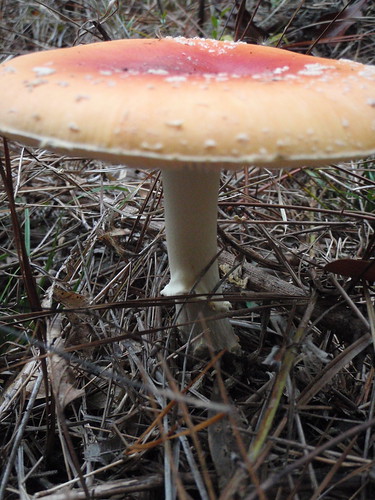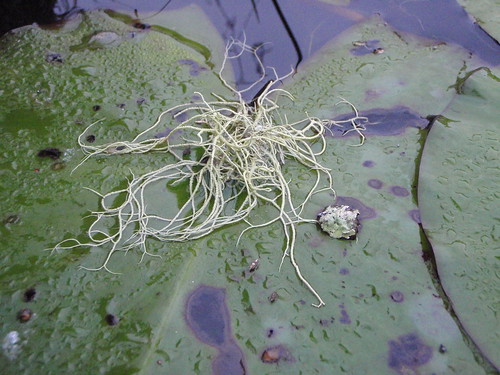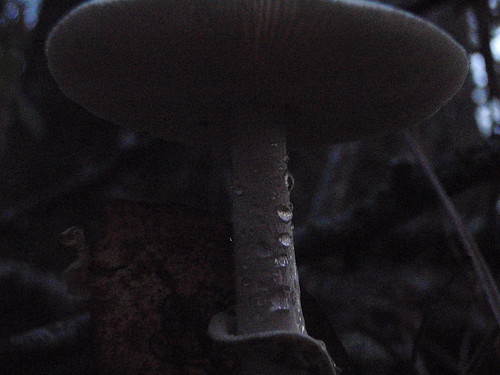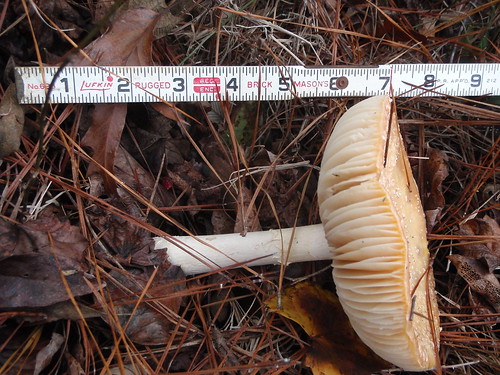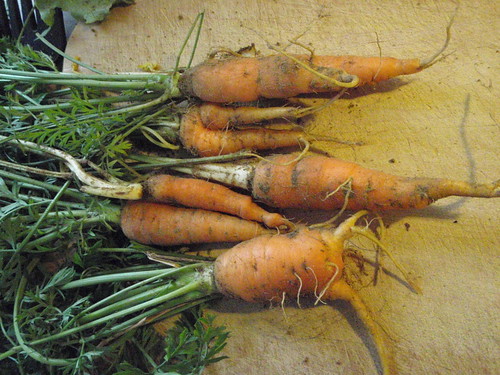Coming in for a landing: Continue reading
Yearly Archives: 2009
Lily moss
Mistletoe
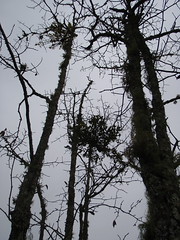 Actually, it’s evergreen, so you can see it all year if you want to; we just go looking for it around the winter solstice.
Actually, it’s evergreen, so you can see it all year if you want to; we just go looking for it around the winter solstice.
Phoradendron leucarpum (aka Phoradendron serotinum) is the common American mistletoe, one of 1300 species of mistletoe worldwide. It’s poisonous, and like many poisonous plants, had traditional medicinal uses. Nowadays it’s mainly noted as a forestry pest because it’s a parasite that takes resources from its host tree, although it is being studied for various pharmacological uses.
And a certain well-known friendly use.
It ranges from New Mexico to New York by way of Florida. And Georgia.
Curiously, the USDA Plants Profile shows none in Lowndes County, Georgia.

Pictures by Gretchen Quarterman, 13 Dec 2009, Lowndes County, Georgia.
The World Inside Monsanto
 In
a review of the 2008 film, The World According to Monsanto,,
Kimberley D. Mok remarks:
In
a review of the 2008 film, The World According to Monsanto,,
Kimberley D. Mok remarks:
The film documents the beginnings of the company as a chemical start-up in the early 1900s, producing saccharin, caffeine and vanillin. As we watch Robin Google up unclassified documents and interview a bevy of officials, scientists and farmers, we see that today’s Monsanto is a giant multinational wielding its considerable financial, political and marketing clout to influence government officials, ruthlessly sue farmers using patent laws – all the while surreptitiously lobbying to keep their potentially toxic products unlabelled or falsely advertised.The future? Already Monsanto seeds grow 93% of soybeans and 80% of corn in the U.S. and people claim “we couldn’t do agriculture in Argentina” without RoundUp. The Biotechnology Industry Organization even claims that the popularity of herbicide-resistant crops showed their value outweighs any associated detriments.Monsanto claims that their genetically modified seeds will solve the food crisis, especially in developing countries, where it will provide significant economic benefits, higher quality and better yield. Nevertheless, the film compellingly shows the unsettling possibilities of genetic contamination of conventional or local varieties of seeds by their genetically-engineered cousins, pointing to a horrific future where global plant biodiversity is nil and farmers are not able to grow anything but genetically contaminated food.
Any associated detrimeents, such as birth defects or sickness in animals and humans.
Nevermind that organic farming yields are often better than with agrochemicals.
Surely the company that brought us DDT (banned by U.S. Congress 1972), Agent Orange (Agent Orange Act of 1991 makes U.S. veterans exposed to it eligible for treatment and compenstation), and PCBs (“CONFIDENTIAL: Read and Destroy”) wouldn’t soak the world in anything toxic?
How Monsanto Leverages Patents to Dominate World Food Supply
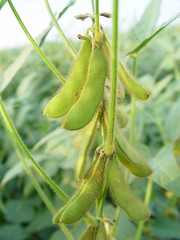
Soybean pods by jwinfred |
Confidential contracts detailing Monsanto Co.’s business practices reveal how the world’s biggest seed developer is squeezing competitors, controlling smaller seed companies and protecting its dominance over the multibillion-dollar market for genetically altered crops, an Associated Press investigation has found.
Why should you care?
Declining competition in the seed business could lead to price hikes that ripple out to every family’s dinner table. That’s because the corn flakes you had for breakfast, soda you drank at lunch and beef stew you ate for dinner likely were produced from crops grown with Monsanto’s patented genes.
Where does Monsanto get such power? Continue reading
White mushroom with dewdrops
5 Inch Mushroom
Carrots
Soy 93% Corn 80% Monsanto
 In addition to the problems produced by the pesticides Monsanto seeds are
developed to be immune to,
Peter Whoriskey writes in the Washington Post
about how 93% of soybeans and 80% of corn grown in the U.S. now
comes from Monsanto-developed seeds.
And during the decade in which that has happened:
In addition to the problems produced by the pesticides Monsanto seeds are
developed to be immune to,
Peter Whoriskey writes in the Washington Post
about how 93% of soybeans and 80% of corn grown in the U.S. now
comes from Monsanto-developed seeds.
And during the decade in which that has happened:
…for farmers such as Lowe, prices of the Monsanto-patented seeds have steadily increased, roughly doubling during the past decade, to about $50 for a 50-pound bag of soybean seed, according to seed dealers.In a blog post about this subject:
Many farmers are fed up with Monsanto’s ruthless use of litigation. All over the United States, the wind is carrying Monsanto’s genetically altered seeds into neighboring fields. Monsanto regularly sends out investigators to visit farms and to test whether any Monsanto strains have shown up on those farms. If they have, then Monsanto proceeds to sue the living daylights out of those farmers.A commenter makes the monoculture point:
They don’t have to be more susceptible to crop diseases. They have extremely low genetic diversity, so a disease that strongly affects that strain of plant will be able to spread over millions of acres of nearly identical targets.Monoculture Monsanto cotton crops have already failed in India. Continue readingThis is exactly what happened to the Irish during the potato famine. The Inca, who discovered the potato, had thousands of varieties. Some resisted blight, some resisted insects, others performed better in dry years, etc.
France Rounds Up Monsanto
 France Finds Monsanto Guilty of Lying:
France Finds Monsanto Guilty of Lying:
France’s highest court has ruled that U.S. agrochemical giant Monsanto had not told the truth about the safety of its best-selling weed-killer, Roundup. The court confirmed an earlier judgment that Monsanto had falsely advertised its herbicide as “biodegradable” and claimed it “left the soil clean.”It’s about time some court decided that. Now let’s hear some U.S. court say the same thing.
Maybe with more of a fine than this:
The company was fined 15,000 euros (£13,800; $22,400).Oh, wait:
Earlier this month, Monsanto reported a fourth quarter loss of $233m (£147m), driven mostly by a drop in sales of its Roundup brand.Now that’s getting closer to an appropriate size. Largely driven by the state of the economy no doubt. How about a court-imposed fine of that size or larger? Monsanto has a market cap of $43.6 billion so larger would be appropriate.
